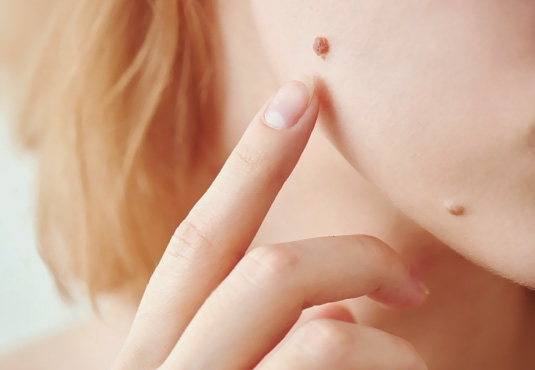
A mole (nevus) is a skin formation made up of pigment cells that give color to our skin. These formations can range in color from light brown to black and can appear either flat or raised on the skin. In this article, we will discuss topics such as "mole removal in Ankara," "how moles are removed," "mole removal surgery in Ankara," and "laser mole removal."
Moles can be either congenital (present at birth) or acquired later in life. Commonly known as moles or skin tags, these formations are seen in nearly every person and are generally benign skin lesions. Moles typically range between 20 to 200 on a person's body.
Congenital moles usually only require monitoring unless exposed to trauma (such as sunlight, UV rays, impact, or scratching). However, if acquired moles show rapid growth, changes in color or shape, they should be evaluated, and removal may be planned to eliminate any potential risk.
If suspicious moles are not removed, there is a risk that they may turn into mole cancer (malignant melanoma).
If mole cancer (malignant melanoma) is detected, a significant surgical procedure is required to remove the lesion with clear surgical margins. Lymph node sampling from the affected area should also be performed, and if lymph node involvement is detected, a lymph node dissection must be carried out. For this reason, all suspicious moles should be carefully monitored and removed if necessary, to prevent the patient from facing both surgical and financial burdens later on.
Moles can be divided into two categories: benign and malignant. The types of moles are as follows:
Moles can be removed in our Ankara clinic through laser or surgical methods. It is recommended to surgically remove suspicious lesions with clear margins.
In both laser and surgical mole removal procedures, it is crucial to select the appropriate treatment, technique, and materials to minimize the potential for scarring and ensure that any scars remain within acceptable limits.
Patients' main concern in these procedures is often the potential for scars. For this reason, necessary precautions should be taken, and the most suitable treatment should be applied.
Moles are removed using methods performed by dermatologists and surgeons. For suspicious lesions, it is important to have clear surgical margins. Therefore, surgical excision is necessary.
The surgical excision procedure is a simple surgical intervention that does not require an operating room and is performed under local anesthesia in outpatient conditions. The procedure typically takes about 10-15 minutes.
During the procedure, the patient does not feel pain and can return to their normal activities afterward. Laser mole removal is applied in outpatient conditions to simple moles that are known to be benign.
Mole removal surgery in Ankara is a simple surgical intervention performed under outpatient conditions without the need for an operating room. The area to be removed is only numbed, so the patient does not feel any pain. There is no work loss, and the patient can comfortably take a bath 24 hours after the procedure.
The cost of mole removal varies depending on the number, size, and location of the moles on the body. For more detailed information, feel free to contact us.
Laser mole removal is a type of intervention applied using a laser device to simple moles known to be benign. It is mostly performed in dermatology clinics.
There is a common belief that removing moles is harmful, but this is not true. On the contrary, it is highly recommended to remove suspicious moles.
The goal is to remove benign moles that could potentially turn suspicious or malignant due to external factors (such as trauma, UV rays, etc.). Otherwise, it could lead to serious health problems.
Removing benign moles does not trigger cancer development, nor does it pose any medical harm. The removal of benign moles is usually for aesthetic purposes and is done at the patient's request.
As with any surgery performed on the skin, a scar will form after mole removal surgery. While it is impossible to completely eliminate the scar, the goal is to minimize it to acceptable levels using the correct surgical technique, appropriate surgical materials, and proper medical treatment.
For simple and small moles, laser treatment performed by dermatologists can be used. However, for suspicious or large moles, surgical removal should be the preferred method.
Since facial moles are important for aesthetics, small moles can be treated with laser, while larger ones can be surgically removed using the appropriate technique.
For skin tags, surgical removal and cauterization are the treatment methods used. Skin tags do not disappear on their own and require intervention.
Similar to other moles, black moles can be removed using either laser treatment or surgical methods.
We are committed to being with you during your treatment process for general surgery diseases with accurate diagnosis and effective treatment methods. Here, you can read the real experiences of my patients who share their health journey with me. Their sincere comments can be a guide for you as well.